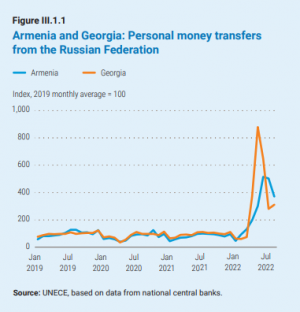Geneva and Moscow, 25 January - The economic growth in the Commonwealth of Independent States and Georgia will contract in 2023, albeit by a smaller margin than was previously expected, according to the United Nations World Economic Situation and Prospects (WESP) 2023, which was launched today.
A series of severe and mutually reinforcing shocks — the COVID-19 pandemic, the war in Ukraine and resulting food and energy crises, surging inflation, as well as the climate emergency — battered the world economy in 2022.
Against this backdrop, world output growth is projected to decelerate from an estimated 3.0 per cent in 2022 to 1.9 per cent in 2023, marking one of the lowest growth rates in recent decades.
The economic outlook for the near term is gloomy and uncertain. Global growth is forecast to moderately pick up to 2.7 per cent in 2024 as some of the headwinds will begin to subside. However, this is highly dependent on the pace and sequence of further monetary tightening, the course and consequences of the war in Ukraine, and the possibility of further supply-chain disruptions. The tepid global economic prospects also threaten the achievement of the 17 Sustainable Development Goals (SDGs), whose mid-point review lies ahead at the 2023 SDG Summit in September.
“This is not the time for short-term thinking or knee-jerk fiscal austerity that exacerbates inequality, increases suffering and could put the SDGs farther out of reach. These unprecedented times demand unprecedented action,” said António Guterres, United Nations Secretary-General. “This action includes a transformative SDG stimulus package, generated through the collective and concerted efforts of all stakeholders,” he added.
The Commonwealth of Independent States and Georgia: in the shadow of war in Ukraine The war in Ukaine has pushed the world on the brink of the most severe global cost-of-living crisis in a generation, affecting the lives and livelihoods of an estimated 1.6 billion people. The war has also been the single biggest determinant of the economic situation in the Commonwealth of Independent States and Georgia. About a third of Ukrainian output has been lost, and the contraction of the Russian economy is affecting the rest of the region through migration, remittances and commodity prices. Fiscal space remains largely constrained, limiting the scope for public spending to stimulate growth. Political and economic fallout from the conflict are likely to continue to shape trade and finance flows in CIS countries and the overall framework of their integration into the global economy. The aggregate GDP of the Commonwealth of Independent States and Georgia is estimated to have contracted by 3.3 per cent in 2022. In 2023, the aggregate GDP of the region (excluding Ukraine, for which a forecast is not available), is expected to shrink by further 1 per cent, expanding subsequently by a modest 2.3 per cent in 2024. These assessments are especially sensitive to the course and duration of the war.
Russian economy in 2022 performed better than was anticipated earlier, but will shrink further in 2023
Following the start of the war in Ukraine, initial expectations were for a contraction of the Russian economy to about 10 to 15 per cent in 2022. In practice, the contraction has been just around 3 per cent. High inventory levels allowed many firms to maintain production for some period, while drastic actions of the Central Bank maintained financial stability. The strong appreciation of the Russian currency due to large current account surplus and capital controls contributed to stabilizing inflation and supported a reversal of initial monetary tightening, restoring credit flows to the private sector. However, if the current situation continues, the Russian economy is expected to contract by a further 2.9 per cent in 2023.
Ukrainian economy contracted sharply; some others posted strong growth in 2022
The economy of Ukraine has suffered an over 30 per cent contraction in 2022 owing to the massive destruction of its physical infrastructure, disruption of production and trade activities, significant shrinking of the labour force and large-scale population displacement. Post-conflict reconstruction will require immense financial resources. Several other CIS economies performed significantly better, registering, in some cases, double-digit growth rates with relocation of Russian businesses and populations, and increased exports to the Russian market.
Near-term outlook for the CIS region remains fragile
The near-term economic outlook for the region remains fragile amid significant downside risks, compounded by tightening global financial conditions, a prolonged war, and high levels of geopolitical uncertainty. Monetary tightening in most of the region in response to elevated inflation, and the overall weak global economic environment will lead to slow growth in the region.
South-Eastern Europe: From a strong start in early 2022 to slowing activity
South-Eastern European economies saw modest economic expansion in 2022. The main driver was strong domestic demand, and, in some cases, a good tourist season. High energy costs and severe drought in the region, however, had negative impacts on agriculture and hydropower generation, impeding growth momentum towards the end of the year. The aggregate GDP of South-Eastern Europe is expected to have expanded by 2.8 per cent in 2022, with growth moderating to 2.3 per cent in 2023 and rebounding to 2.8 per cent in 2024. Slower economic activity in the EU, the main trading partner and source of remittances, will weigh negatively on the region’s near-term growth prospects.


